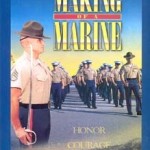MCRD “Marine Corps Recruit Depot” Boot Camp
A Brief history of Marine Boot Camp
For most of the Marine Corps’ history, there was no highly structured program of instruction for Marine recruits, such as we know today. Only in the last 90 years have there been centralized recruit depots with the mission of transforming civilians into basically trained Marines prepared to perform on the battlefield.
Early Marine recruit training was conducted at various posts and stations by noncommissioned officers who trained recruits in the “principles of military movements” and the use of the rifle. Commandant Franklin Wharton, who led the Corps from 1804 until his death in 1818, was the first to recognize the need for organized training and created a school for Marine recruits at the Marine Barracks in Washington where young men learned the basics of discipline, drill, the manual of arms and marksmanship.
Interested in a DVD of Marine Corps Boot Camp?
Order
your copy of “The Making of a Marine” video today!
The sea-going nature of the Marine Corps, however, coupled with the recurring shortages of money and men, kept the Marine Corps system for training recruits quite primitive throughout the 19th century. In 1911, however, Major General William P. Biddle, 11th Commandant of the Marine Corps, instituted some sweeping changes that would have profound and long-lasting effects on the training of Marines.
On assuming command of the Corps, Biddle made two months of recruit training mandatory and set up four recruit training depots – at Philadelphia, Norfolk (later at Port Royal, South Carolina), Puget Sound, Washington, and Mare Island, California. Mare Island became the sole west coast depot during the following year, and east coast recruit training was shifted to Parris Island, South Carolina, in 1915. The training program Biddle outlined included drill, physical exercise, personal combat, and intensive marksmanship qualification with the recently-adopted M1903 Springfield rifle.
General Biddle’s innovation met its first real test during World War I when the Corps expanded from about 15,000 to nearly 70,000 Marines in less than 18 months. During that period, the recruit training load expanded from 835 to a peak of 13,286. Living conditions at both depots were Spartan and the training was intense. Upon completion of recruit training, Marines received additional pre-embarkation training at Quantico, Virginia, and still more training after arriving in France.
During the summer of 1923, the west coast recruit depot was moved from Mare Island to San Diego, California. Training programs at the two recruit depots included three weeks of basic indoctrination, an equal period of time on the rifle range, and the final two weeks was occupied in bayonet drill, guard duty, drill and ceremonies.
During September 1939, shortly after the German invasion of Poland, expansion of the Corps from 18,000 to 25,000 Marines was authorized. The recruit syllabus was halved to four weeks to meet this goal, but the result was a decline in training standards and rifle qualification rates plummeting to new lows. From this experience came the realization that seven to eight weeks is the minimum amount of time required for adequate recruit training. The World War II recruit training formula did not vary greatly from World War I except in the overwhelming number of Marines to be trained — nearly half a million men over a four year period. It was during the war, though, that a third recruit training facility was established at Montford Point, North Carolina, to train some 20,000 black Marines. Recruit training was fully integrated and Montford Point put to other use in 1949.
The outbreak of war in Korea saw recruit training spring into high gear once again as fresh replacements, only weeks beyond recruit training, performed creditable combat service at the demanding battles of Inchon, Seoul, and the Chosin Reservoir. After the war, the recruit syllabus returned to 10 weeks from the war-shortened 8-week schedule.
The period of active American involvement in Vietnam, from 1965 through 1970, saw recruit training reduced to nine weeks. Graduates moved directly from their depots to either Camp Lejeune or Camp Pendleton for additional infantry training, much as their World War II counterparts had done.
The past forty years have witnessed the continuing close scrutiny of the Marine Corps recruit training program. Concerted efforts have been made to eliminate the excesses that had crept into the system over the years while at the same time retaining those elements of the recruit training experience that have produced a highly trained and motivated fighting force. Officer supervision and special training units, along with other innovations for enhancing the effectiveness of recruiting training, were implemented during these decades. The goal, as articulated by Commandant of the Marine Corps General Randolph McCall Pate in 1956, has been “to preserve, protect, and improve the actual system of recruit training which has served us so well.”
Reference Section
History and Museums Division
December 2001
Without doubt, Marine Corps boot camp is more challenging — both physically and mentally — than the basic training programs of any of the other military services. Not only are these requirements much higher, but recruits are required to learn and adhere to the core values of Honor, Courage, and Commitment.
Recruits arrive at boot camp. Gear is issued, and a battery of physical examinations is conducted to ensure safety. The Initial Strength Test (IST) is then administered. Later they will learn weapons handling from trained experts and complete the 11-obstacle Confidence Course.
It has been said time and time again by former Marines that Marine Corps recruit training was the most difficult thing they ever had to do in their entire lives. In order to train the world’s most elite fighting force, it has to be that way.
During this time the recruits can receive letters but nothing else — so please do not send gifts or supplies. This is Recruit Training, so don’t address letters with “Marine” or a rank, like “Private.” This is a title they will earn after they successfully complete training.
Interested in a DVD of the Marine Corps Crucible?
Order
your copy of “The Crucible” Marine video today!



